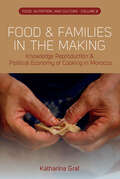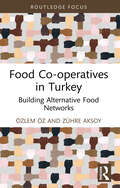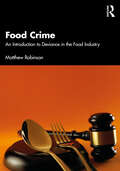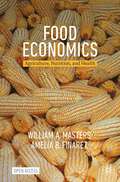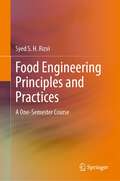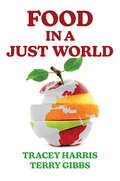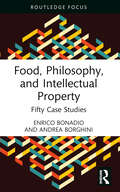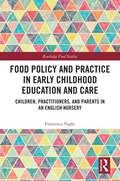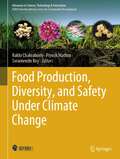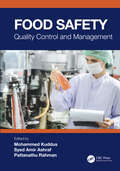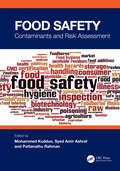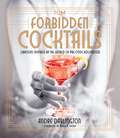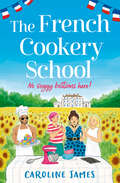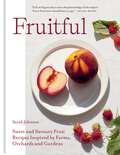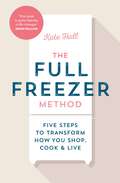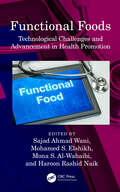- Table View
- List View
Food and Families in the Making: Knowledge Reproduction and Political Economy of Cooking in Morocco (Food, Nutrition, and Culture #8)
by Katharina GrafEven in the context of rapid material and social change in urban Morocco, women, and especially those from low-income households, continue to invest a lot of work in preparing good food for their families. Through the lens of domestic food preparation, this book looks at knowledge reproduction, how we know cooking and its role in the making of everyday family life. It also examines a political economy of cooking that situates Marrakchi women’s lived experiences in the broader context of persisting poverty and food insecurity in Morocco.
Food Co-operatives in Turkey: Building Alternative Food Networks (Routledge Focus on Environment and Sustainability)
by Özlem Öz Zühre AksoyThis book addresses the roles played by food co-operatives in the attempt to build alternative food networks, drawing on an in-depth analysis of case studies in Turkey. While many existing studies focus on food co-operatives and alternative food networks in the Global North, this book provides an important insight into a country from the Global South and, in doing so, not only provides a novel perspective but also challenges the rigid North–South categorization. The book provides a rounded view by examining both a producer and a consumer co-operative: BÜKOOP is a university-based consumer food co-operative, and the Vakıflı co-operative is a food-producing co-operative located in the Hatay province on the Mediterranean coast of Turkey. These two co-operatives, which have been working together for more than ten years, share the dream of establishing a network of co-operatives, in which producers exist in solidarity with consumers, blurring the dichotomy of producer versus consumer as well as rural versus urban. In addition to contributing towards a better understanding of the urban–rural divide, within the framework of alternative food networks, the in-depth analysis of these two cases enables us to explore how food co-operatives develop and how they keep their commitment to their original goals and ideals so as to help build an alternative food system. The lessons we learn from these two working case examples highlight the successes and areas of improvement for food co-operatives. They also provide evidence against the pessimism about alternative food networks by demonstrating that co-operatives can democratize both production and consumption. This book will be of interest to students and scholars studying alternative food networks, food justice, food sovereignty, transformation towards sustainable food systems, social movements, and the urban–rural divide.
Food Co-operatives in Turkey: Building Alternative Food Networks (Routledge Focus on Environment and Sustainability)
by Özlem Öz Zühre AksoyThis book addresses the roles played by food co-operatives in the attempt to build alternative food networks, drawing on an in-depth analysis of case studies in Turkey. While many existing studies focus on food co-operatives and alternative food networks in the Global North, this book provides an important insight into a country from the Global South and, in doing so, not only provides a novel perspective but also challenges the rigid North–South categorization. The book provides a rounded view by examining both a producer and a consumer co-operative: BÜKOOP is a university-based consumer food co-operative, and the Vakıflı co-operative is a food-producing co-operative located in the Hatay province on the Mediterranean coast of Turkey. These two co-operatives, which have been working together for more than ten years, share the dream of establishing a network of co-operatives, in which producers exist in solidarity with consumers, blurring the dichotomy of producer versus consumer as well as rural versus urban. In addition to contributing towards a better understanding of the urban–rural divide, within the framework of alternative food networks, the in-depth analysis of these two cases enables us to explore how food co-operatives develop and how they keep their commitment to their original goals and ideals so as to help build an alternative food system. The lessons we learn from these two working case examples highlight the successes and areas of improvement for food co-operatives. They also provide evidence against the pessimism about alternative food networks by demonstrating that co-operatives can democratize both production and consumption. This book will be of interest to students and scholars studying alternative food networks, food justice, food sovereignty, transformation towards sustainable food systems, social movements, and the urban–rural divide.
Food Crime: An Introduction to Deviance in the Food Industry
by Matthew RobinsonThis book addresses the various forms of deviance and criminality found within the conventional food system. This system—made up of numerous producers, processors, distributors, and retailers of food—has significant, far-reaching consequences bearing upon the environment and society.Food Crime broadly outlines the processes and impacts of this food system most relevant for the academic discipline of criminology, with a focus on the negative health outcomes of the US diet (e.g., obesity and diabetes) and negative outcomes associated with the system itself (e.g., environmental degradation). The author introduces the concept of "food criminology," a new branch of criminology dedicated to the study of deviance in the food industry. Demonstrating the deviance and criminality involved in many parts of the conventional food system, this book is the first to provide exhaustive coverage of the major issues related to what can be considered food crime. Embedded in the context of state-corporate criminality, the concepts and practices exposed in this book bring attention to harms associated with the conventional food system and illustrate the degree of culpability of food companies and government agencies for these harms.This book is of interest to students, scholars, and practitioners seeking a more just and healthy food system and encourages further future research into food crimes in the disciplines of criminology, criminal justice, and sociology.
Food Crime: An Introduction to Deviance in the Food Industry
by Matthew RobinsonThis book addresses the various forms of deviance and criminality found within the conventional food system. This system—made up of numerous producers, processors, distributors, and retailers of food—has significant, far-reaching consequences bearing upon the environment and society.Food Crime broadly outlines the processes and impacts of this food system most relevant for the academic discipline of criminology, with a focus on the negative health outcomes of the US diet (e.g., obesity and diabetes) and negative outcomes associated with the system itself (e.g., environmental degradation). The author introduces the concept of "food criminology," a new branch of criminology dedicated to the study of deviance in the food industry. Demonstrating the deviance and criminality involved in many parts of the conventional food system, this book is the first to provide exhaustive coverage of the major issues related to what can be considered food crime. Embedded in the context of state-corporate criminality, the concepts and practices exposed in this book bring attention to harms associated with the conventional food system and illustrate the degree of culpability of food companies and government agencies for these harms.This book is of interest to students, scholars, and practitioners seeking a more just and healthy food system and encourages further future research into food crimes in the disciplines of criminology, criminal justice, and sociology.
Food Economics: Agriculture, Nutrition, and Health (Palgrave Studies in Agricultural Economics and Food Policy)
by William A. Masters Amelia B. FinaretFood Economics provides a unified introduction to the economics of agricultural production, business decisions, consumer behavior, and the government policies that shape our food system. This open access textbook begins with economic principles derived using graphical techniques to explain and predict observed prices, quantities, and other outcomes as a result of individual choices influenced by market structure and public policies. The second half of the book explores available data globally and for the US, covering a wide range of questions in agriculture and economic development, food marketing, and consumption. Food Economics and its accompanying online resources are designed for advanced undergraduate or introductory graduate courses in agriculture, food, and nutrition policy. The book covers the standard diagrams taught in principles-level courses, with concrete examples and practical insights regarding food production, consumption, and trade. Online resources include data sources, and course materials, including slides, exercises, exams, and answer keys.
Food Engineering Principles and Practices: A One-Semester Course
by Syed S. RizviThis textbook is designed for a one-semester course on Food Engineering, and it offers a concise, in-depth and integrated introduction to the fundamental engineering and physicochemical principles and practices of utility in food processing and manufacturing operations. The textbook includes topics mandated by the Institute of Food Technologists for accreditation of Food Science curricula and helps prepare the students better for taking advance courses related to unit operations in food manufacturing. It is also relevant for Food Process Engineering courses, containing materials that most instructors can cover in three semester hours of instruction. In the first three chapters, readers will find an overview of the basic knowledge of physics and chemistry and an introduction to the engineering language needed to eliminate confusion going forward. In the following chapters, the author covers the main concepts of food thermodynamics, heat transfer–radiation in foodmaterials, mass transfer and fluid dynamics in food, along with real-life examples and exercises to help students relate better to the topics. The author also gives a brief introduction to the main mathematical and analytical concepts required in food engineering.This textbook equips readers to understand a diversity of food engineering related topics and each chapter is enriched with practical examples and Check Your Understanding sections, as well as several problems. The textbook is aimed at undergraduate food science students in their first required introductory food engineering course, but practitioners involved in designing, optimizing, and managing the processing of food products will also find it a useful account.
Food in a Just World: Compassionate Eating in a Time of Climate Change
by Tracey Harris Terry GibbsFood in a Just World examines the violence, social breakdown, and environmental consequences of our global system of food production, distribution, and consumption, where each step of the process is built on some form of exploitation. While highlighting the broken system’s continuities from European colonialism, the authors argue that the seeds of resilience, resistance, and inclusive cultural resurgence are already being reflected in the day-to-day actions of communities around the world. Calling for urgent change, the book looks at how genuine democracy would give individuals and communities meaningful control over the decisions that impact their lives when seeking to secure humanely this most basic human need. Drawing on the perspectives of advocates, activists, workers, researchers, and policymakers, Harris and Gibbs explore the politics of food in the context of capitalist globalization and the climate crisis, uncovering the complexities in our relationships with one another, with other animals, and with the natural world.
Food, Philosophy, and Intellectual Property: Fifty Case Studies
by Enrico Bonadio Andrea BorghiniThis is a book about food, philosophy, and intellectual property rights.Taken separately, these are three well-known subjects, but it is uncommon to consider them together. The book comprises 50 case studies, organized around eight themes: images; genericity and descriptiveness; language traps; procedures; menus, recipes, and creativity; boundaries; biotech; and empowerment. The introductory chapter frames the selection of cases and encourages readers to look beyond them, envisaging new lenses to look at food vis-à-vis intellectual property. The terrain encompassed is wide-ranging and reaches out to fine-grained aspects of food products, recipes, and cooking. Conceived for a wide scope of readers, the volume ultimately interrogates the links between food and cultural identity, bringing to the fore the ethical, political, and aesthetic worth of culinary arts and gastronomic experiences.This accessible book will be of value to scholars, students, practitioners, and others with interests in the areas of intellectual property, food law, and food studies.
Food, Philosophy, and Intellectual Property: Fifty Case Studies
by Enrico Bonadio Andrea BorghiniThis is a book about food, philosophy, and intellectual property rights.Taken separately, these are three well-known subjects, but it is uncommon to consider them together. The book comprises 50 case studies, organized around eight themes: images; genericity and descriptiveness; language traps; procedures; menus, recipes, and creativity; boundaries; biotech; and empowerment. The introductory chapter frames the selection of cases and encourages readers to look beyond them, envisaging new lenses to look at food vis-à-vis intellectual property. The terrain encompassed is wide-ranging and reaches out to fine-grained aspects of food products, recipes, and cooking. Conceived for a wide scope of readers, the volume ultimately interrogates the links between food and cultural identity, bringing to the fore the ethical, political, and aesthetic worth of culinary arts and gastronomic experiences.This accessible book will be of value to scholars, students, practitioners, and others with interests in the areas of intellectual property, food law, and food studies.
Food Policy and Practice in Early Childhood Education and Care: Children, Practitioners, and Parents in an English Nursery (Routledge Food Studies)
by Francesca VaghiThis book is about food and feeding in early childhood education and care, offering an exploration of the intersection of children’s food, education, family intervention, and public health policies. The notion of ‘good’ food for children is often communicated as a matter of common sense by policymakers and public health authorities; yet the social, material, and practical aspects of feeding children are far from straightforward. Drawing on a detailed ethnographic study conducted in a London nursery and children’s centre, this book provides a close examination of the practices of childcare practitioners, children, and parents, asking how the universalism of policy and bureaucracy fits with the particularism of feeding and eating in the early years. Looking at the unintended consequences that emerged in the field, such as contradictory public health messaging and arbitrary policy interventions, the book reveals the harmful assumptions about disadvantaged groups that are perpetuated in policy discourse, and challenges the constructs of individual choice and responsibility as main determinants of health. Children’s food practices at the nursery are examined to explore the notion that, whilst for adults it is what children eat that often matters most, to children it is how they eat that is more important. This book contributes to a growing body of literature evidencing how children’s food is a contested domain, in which power relations are continuously negotiated. This raises questions not only on how children can be included in policy beyond a tokenistic involvement but also on what children’s well-being might mean beyond the biomedical sphere. The book will particularly appeal to students and scholars in food and health, food policy, childhood studies, and medical anthropology. Policymakers and non-governmental bodies working in the domains of children’s food and early years policies will also find this book of interest.
Food Policy and Practice in Early Childhood Education and Care: Children, Practitioners, and Parents in an English Nursery (Routledge Food Studies)
by Francesca VaghiThis book is about food and feeding in early childhood education and care, offering an exploration of the intersection of children’s food, education, family intervention, and public health policies. The notion of ‘good’ food for children is often communicated as a matter of common sense by policymakers and public health authorities; yet the social, material, and practical aspects of feeding children are far from straightforward. Drawing on a detailed ethnographic study conducted in a London nursery and children’s centre, this book provides a close examination of the practices of childcare practitioners, children, and parents, asking how the universalism of policy and bureaucracy fits with the particularism of feeding and eating in the early years. Looking at the unintended consequences that emerged in the field, such as contradictory public health messaging and arbitrary policy interventions, the book reveals the harmful assumptions about disadvantaged groups that are perpetuated in policy discourse, and challenges the constructs of individual choice and responsibility as main determinants of health. Children’s food practices at the nursery are examined to explore the notion that, whilst for adults it is what children eat that often matters most, to children it is how they eat that is more important. This book contributes to a growing body of literature evidencing how children’s food is a contested domain, in which power relations are continuously negotiated. This raises questions not only on how children can be included in policy beyond a tokenistic involvement but also on what children’s well-being might mean beyond the biomedical sphere. The book will particularly appeal to students and scholars in food and health, food policy, childhood studies, and medical anthropology. Policymakers and non-governmental bodies working in the domains of children’s food and early years policies will also find this book of interest.
Food Production, Diversity, and Safety Under Climate Change (Advances in Science, Technology & Innovation)
by Rakhi Chakraborty Piyush Mathur Swarnendu RoyThis book presents a universal picture of the impact of climate change on food production, diversity, and concerns regarding food safety. The book also highlights the traditional and modern techniques for sustainably improving the production of food crops and their nutritional quality aligning with the “zero hunger” goal (Sustainable Development Goal 2) of the United Nations. The book holistically includes the contributions of scientists and academicians working in the fields of Food and Nutrition, Plant and Microbial Sciences, Agriculture, etc. The book also offers insights into the strategies adopted worldwide for ensuring food availability and safety, taking the aid of advanced technologies like climate-smart agriculture along with nanotechnology and artificial intelligence in the event of climate change. Above all, the book transpires the subject matter using illustrative figures and outlines and therefore will be an asset for the post-graduate students, researchers, and faculties.
Food Safety: Quality Control and Management
by Mohammed Kuddus Syed Amir Ashraf Pattanathu RahmanThis book is an updated reference source on food safety best practices. The chapters discuss analytical approaches to measuring food contaminants, quality control and risk assessment of food storage, food irradiation, etc. The contributors discuss how quality control and management help to establish sustainable and secure food systems globally. The book covers topics such as techniques to measure food contaminants, toxins, heavy metals and pesticide content in food.FEATURES Examines the role of food safety approaches in global food supply chains Describes various detection techniques for food contaminants and toxins Discusses the application of nanotechnology and other innovations in food safety and risk assessment Reviews the international regulations for management of food hazards Includes the hazard analysis critical control points (HACCP) principles This book is an essential resource to help students, researchers, and industry professionals understand and address day-to-day problems regarding food contamination and safety and their impact on human health.
Food Safety: Quality Control and Management
by Mohammed Kuddus Syed Amir Ashraf Pattanathu RahmanThis book is an updated reference source on food safety best practices. The chapters discuss analytical approaches to measuring food contaminants, quality control and risk assessment of food storage, food irradiation, etc. The contributors discuss how quality control and management help to establish sustainable and secure food systems globally. The book covers topics such as techniques to measure food contaminants, toxins, heavy metals and pesticide content in food.FEATURES Examines the role of food safety approaches in global food supply chains Describes various detection techniques for food contaminants and toxins Discusses the application of nanotechnology and other innovations in food safety and risk assessment Reviews the international regulations for management of food hazards Includes the hazard analysis critical control points (HACCP) principles This book is an essential resource to help students, researchers, and industry professionals understand and address day-to-day problems regarding food contamination and safety and their impact on human health.
Food Safety: Contaminants and Risk Assessment
by Mohammed Kuddus Syed Amir Ashraf Pattanathu RahmanFood Safety: Contaminants and Risk Assessment is a state-of-art reference on food safety, which is the biggest challenge in the food supply chains worldwide. Despite advancements in hygiene, food treatment, and food processing, foodborne pathogens or food contaminants still represent a significant threat to human health. This book presents comprehensive information about the major food contaminants across food types. The text provides facts about setting up food safety initiatives and safety rules, foodborne pathogen detection, production and processing compliance issues, and safety education.Key Features Examines a diverse range of contaminants across food types Describes various food allergens and allergies Discusses contamination in drinking water and bottled water Reviews the international regulations for management of food hazards Throws light on the overall impact of food safety of global food supply chains This book is meant for postgraduate students, researchers, and food industry professionals.
Food Safety: Contaminants and Risk Assessment
Food Safety: Contaminants and Risk Assessment is a state-of-art reference on food safety, which is the biggest challenge in the food supply chains worldwide. Despite advancements in hygiene, food treatment, and food processing, foodborne pathogens or food contaminants still represent a significant threat to human health. This book presents comprehensive information about the major food contaminants across food types. The text provides facts about setting up food safety initiatives and safety rules, foodborne pathogen detection, production and processing compliance issues, and safety education.Key Features Examines a diverse range of contaminants across food types Describes various food allergens and allergies Discusses contamination in drinking water and bottled water Reviews the international regulations for management of food hazards Throws light on the overall impact of food safety of global food supply chains This book is meant for postgraduate students, researchers, and food industry professionals.
Food Shortage Crisis: Origins and Global Impact
by Dawn M. DrakeDiscover the history, causes, impacts, and potential future of global food shortages-a problem for all of humanity, not just the developing world.This important reference work takes an in-depth look at the geographic nature of the problem of global food shortages, helping readers to understand that while this is not a problem that exists everywhere, it is a problem that touches everyone. The book begins with an introduction to the basics of global food shortages, moves through the history of the issue, and then explains the current state of affairs. From there, it examines root causes, proposes solutions, and takes a speculative look into the future. This organization moves readers through the problem in a systematic and easy-to-follow manner, while also allowing them to explore each aspect of the issue individually. A curated selection of further readings at the end of each chapter points readers toward resources for additional research and discovery. The book concludes with a selection of perspective essays written by expert contributors. Each explores a different facet of the topic, from the potential of GMO crops to the impact of food waste.Food Shortage Crisis illustrates that the problems of food scarcity and insecurity are neither new nor confined to the developing world. They are the result of a complex interplay of issues at every stage of the process of feeding humanity, from food production to sale and distribution to consumption. Age-old factors such as poverty and inequality are compounded by new realities such as climate change. Global food shortages affect more than human health; they have the potential to cause economic devastation, trigger civil unrest and international conflicts, and change how we as humans interact with the planet and each other.
Forbidden Cocktails: Libations Inspired by the World of Pre-Code Hollywood
by André DarlingtonA stunning package for classic film buffs and drinks enthusiasts alike, all the &“forbidden&” fun of Pre-Code Hollywood and the Prohibition and speakeasy era meet in this stylish cocktail book. What might Jean Harlow have sipped for Dinner at Eight? What did Barbara Stanwyck take to steel herself in Baby Face? If you&’re a classic film fan who&’s ever pondered these questions, or are a bartender or at-home entertainer who adores Prohibition-era cocktails, this guide to mixed drinks inspired by Pre-Code Hollywood is essential reading. The stars and stories of the &“forbidden&” time in moviemaking before strict censorship was enforced and the movies reflected a raucous freedom that would be unseen again for decades take the spotlight in Forbidden Cocktails. With 50 film-and-drink pairings and packaged handsomely with more than 100 full-color and black-and-white photos throughout, this is a practical and stunning homage to a singularly exuberant and evocative era. Movie-and-cocktail pairings include: The Divorcee / Balanced Account; Hell&’s Angels / Platinum Blonde; Dracula / Count Draiquiri; Strangers May Kiss / Stranger&’s Kiss; The Public Enemy / Tom Powers; Night Nurse / My Pal Rye; Shanghai Express / Shanghai Lily; Scarface / First Ward; One Way Passage / Passage to Paradise; Trouble in Paradise / Lubitsch Touch; Call Her Savage / Greenwich Village; Sign of the Cross / Naked Moon; Gold Diggers of 1933 / Pettin&’ in the Park; Flying Down to Rio / Hotel Hibiscus; It Happened One Night / It Happened One Morning; The Thin Man / Asta
The French Cookery School
by Caroline JamesPre-order the brand new romcom from the bestselling author of The Cruise!
Fruit Fortification of Craft Beer
by Manju Nehra Nishant Grover K.S. Sandhu Rahul ThoryBeer has been one of the staples in alcohol consumption since the earliest civilizations. In the present day, beer is more popular than ever and shows no signs of decreasing in production volume and revenue generation. Some of the most popular craft beer types utilize fruit raw materials in their production, including wheat beers, porters, high gravity beers, stouts and Lambics. There have been multiple sources published over the decades focusing on beer brewing and brewing science, many of which do cover fruit fortifications and craft beer production. Due to the increasing popularity of fruit-fortified craft beers, an updated singular source is needed focusing on the use of fruit raw materials in the brewing process for various types of craft beer. Fruit Fortification of Craft Beer extensively outlines the use of fruits in the brewing and malting processes for all types of popular craft beers, outlining the latest technological and processing advances. Various fruit material additives are covered as are their specific uses in the brewing process, their characteristics and processing methods. The main types of craft beers which utilize fruit additives are covered including their chemical profiles and nutritional aspects. A major aspect of this book is the linking of the past and the future, examining how fruit has been used in beer fortification since ancient times and how the technologies and processing methods have advanced with the increasing popularity of locally-brewed craft beers. In focusing on these advances, this work brings fruit fortification in craft beers up to the present, providing an in-depth source for researchers and brewers.
Fruitful: Sweet and Savoury Fruit Recipes Inspired by Farms, Orchards and Gardens
by Sarah JohnsonThis is a celebration of fruit, and all the glorious variety it can bring to our plates. From crisp apples to buttery pears, fragrant peaches to plump berries, and vibrant lemons to juicy cherries.An introduction covers the key techniques for cooking with fruit, such as roasting, poaching and puréeing. Over 80 recipes follow in chapters on citrus, berries, stone fruit, orchard and vine fruits, pome fruits, shrubs and stalks. From Polenta and Blackberry Muffins and Apricot Muscat Tart, to Pear and Farro Salad, Pan-Fried Duck Breast with Blackcurrant and Mackerel with Gooseberry Compote and Yoghurt, discover the joy and versatility of cooking with fruit. Plus plenty of jams, sorbets and ice creams.Interspersed between the recipes are flavour charts and pairing suggestions for every fruit, alongside four interviews with fruit growers and farmers around the world.Trained by Alice Waters at Chez Panisse, Berkeley, and now Head of Pastry Development at Spring in London and luxury hotel Heckfield Place in Hampshire, Sarah Johnson's recipes are modern, fresh and full of flavour. Her close relationship with the farmers and producers that supply the restaurants has given her a wealth of knowledge on the best fruits to buy and cook, and fantastic tips and tricks to get the most from your produce.
The Full Freezer Method: Five Steps to Transform How You Shop, Cook & Live
by Kate Hall'This book is quite literally a life-changer.' GREGG WALLACE'Making the most of your freezer is the best way to save money and waste less food.' CHRIS BAVIN------------Want to save thousands of pounds on your food bill? Eat a healthy varied diet? Cut down on food waste?The secret to all of this is in your freezer.This simple, five-step organisation guide will change the way you shop, cook and live – saving you money, time and wasted food.Kate Hall has already helped countless people transform their freezers from unloved graveyards of good intentions to organised treasure troves of ingredients ready to make a meal you actually want to eat, without having to pop to the shops or scrimp on quality.With handy illustrations and money-saving tips, The Full Freezer Method will empower you to make lasting change, save you money and actually enjoy the process.
Functional Foods: Technological Challenges and Advancement in Health Promotion
by Sajad Ahmad Wani Mohamed S. Elshikh Mona S. Al-Wahaibi Haroon Rashid NaikIt is reported Functional foods are highly nutritious and associated with a number of powerful health benefits. They may protect against disease, prevent nutrient deficiencies, and promote proper growth and development. Functional Foods: Technological Challenges and Advancement in Health Promotion presents information related to bioactive compounds present in the functional foods, derived from fruits and vegetables, cereals and pulses, dairy and meat, herbs and spices and other foods. It describes novel techniques and methodologies used in the extraction, isolation, encapsulation, identification and characterization of bioactive compounds. Key Features: Covers the most recent research related to the bioactive compounds present in the functional foods Presents the latest information on extraction, isolation, encapsulation, identification and characterization Discusses formulation challenges with an emphasis on stability and safety evaluations of functional foods Finally, it includes substantial and scientific research and innovation for new product development with health benefits. This book will serve as a valuable resource for researchers, academicians, and students interested in many aspects of functional foods.
Functional Foods: Technological Challenges and Advancement in Health Promotion
by Sajad Ahmad Wani, Mohamed S. Elshikh, Mona S. Al-Wahaibi, and Haroon Rashid NaikIt is reported Functional foods are highly nutritious and associated with a number of powerful health benefits. They may protect against disease, prevent nutrient deficiencies, and promote proper growth and development. Functional Foods: Technological Challenges and Advancement in Health Promotion presents information related to bioactive compounds present in the functional foods, derived from fruits and vegetables, cereals and pulses, dairy and meat, herbs and spices and other foods. It describes novel techniques and methodologies used in the extraction, isolation, encapsulation, identification and characterization of bioactive compounds. Key Features: Covers the most recent research related to the bioactive compounds present in the functional foods Presents the latest information on extraction, isolation, encapsulation, identification and characterization Discusses formulation challenges with an emphasis on stability and safety evaluations of functional foods Finally, it includes substantial and scientific research and innovation for new product development with health benefits. This book will serve as a valuable resource for researchers, academicians, and students interested in many aspects of functional foods.
